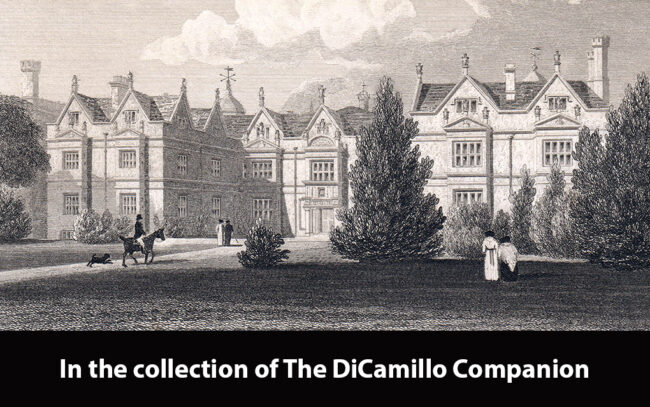
An 1825 engraving of the south (entrance) facade from "Neale's Views of Seats"
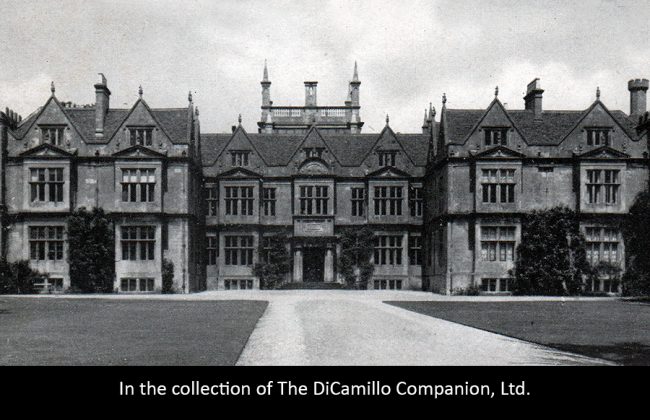
The south (entrance) facade from a circa 1921 postcard
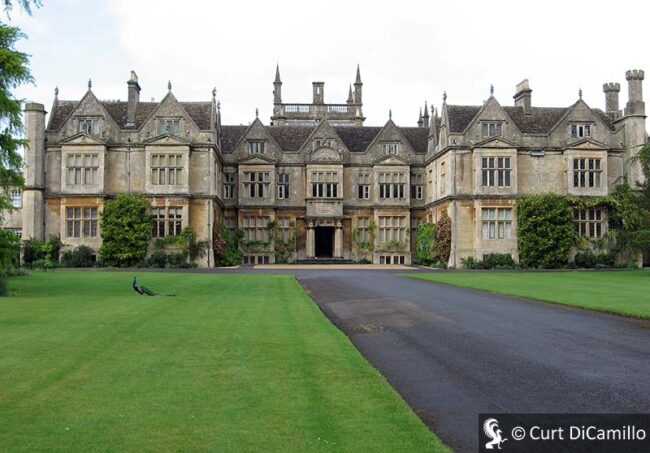
The entrance facade in 2007
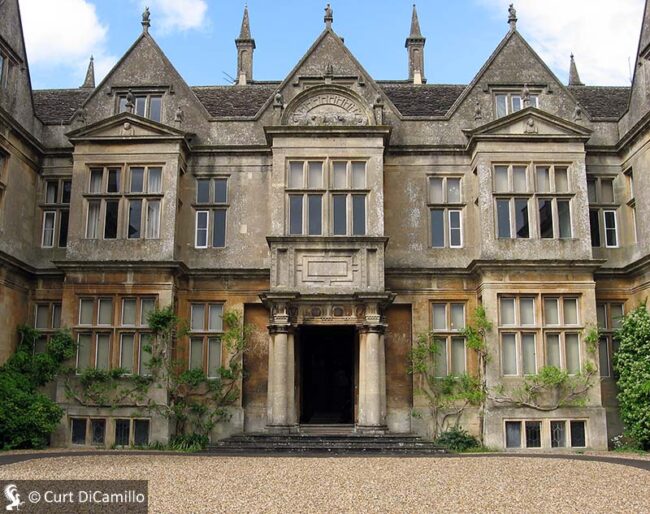
Detail of the entrance facade in 2007
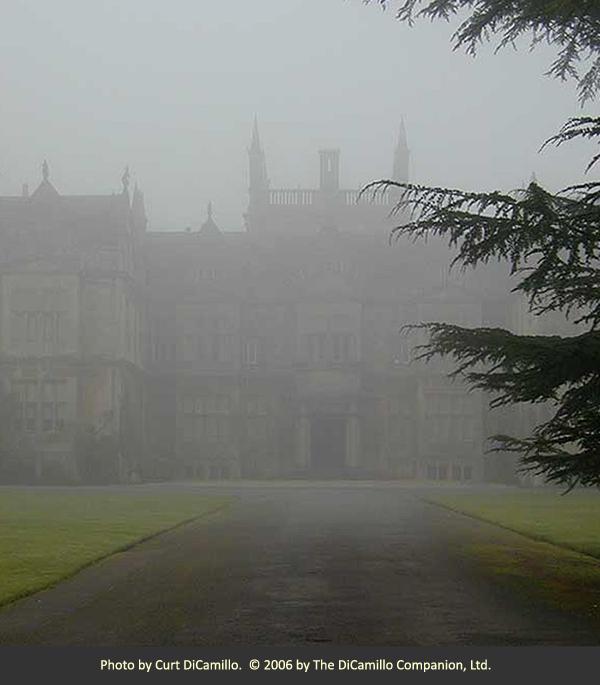
The south (entrance) facade in the mist in 2006
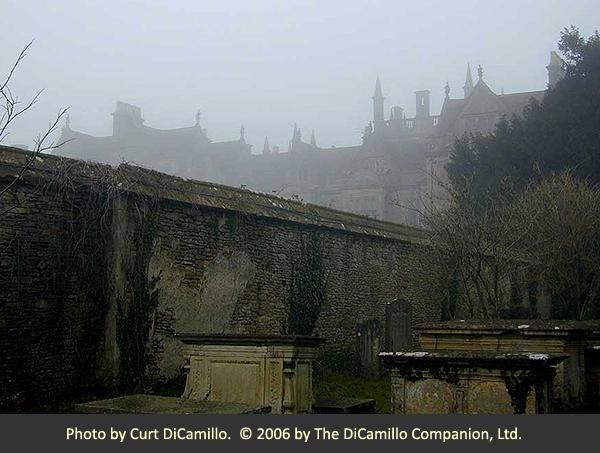
The south (entrance) facade as seen from the misty church graveyard
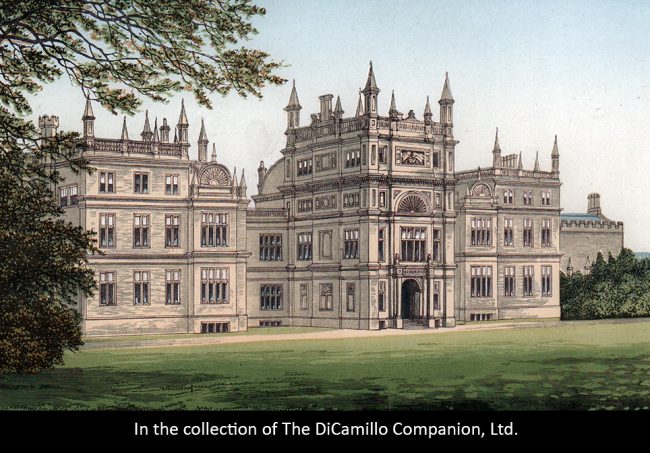
The north (garden) facade after Bellamy's 19th century rebuilding. This lithograph is from the circa 1875 publication "Morris's Views of Seats."
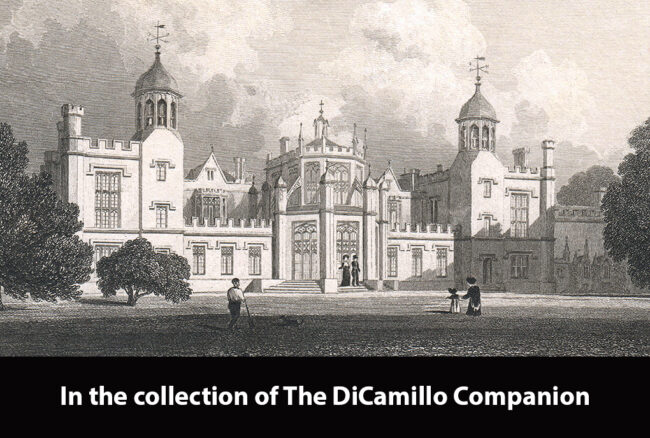
An 1825 engraving of the north (garden) facade from "Neale's Views of Seats. " This image shows the facade after Nash's late 18th century rebuilding, but before Bellamy's 19th century work.
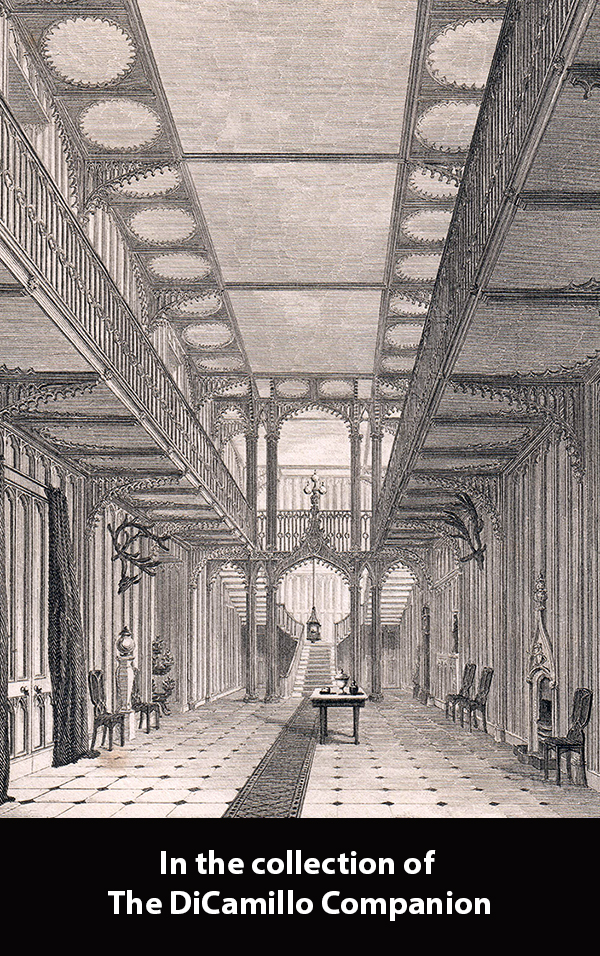
The hall from an 1825 engraving in "Neale's Views of Seats"
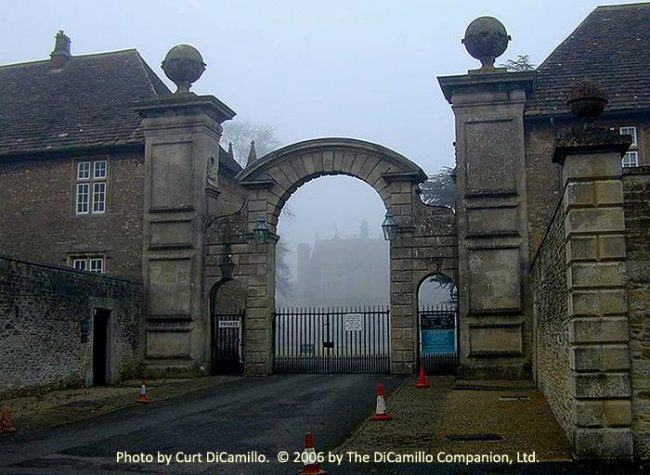
The monumental gateway to the house
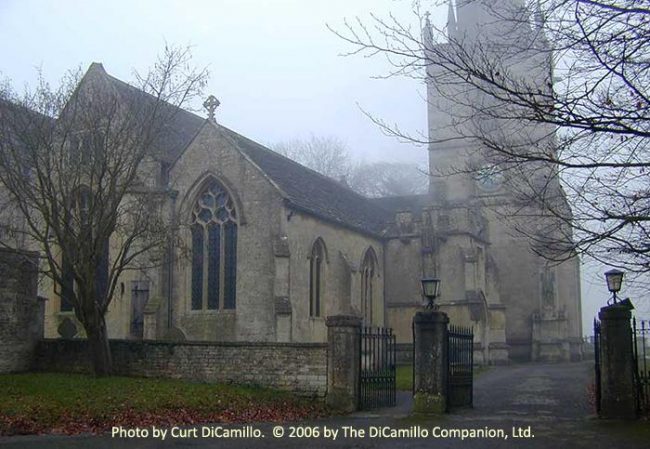
The church in the mist
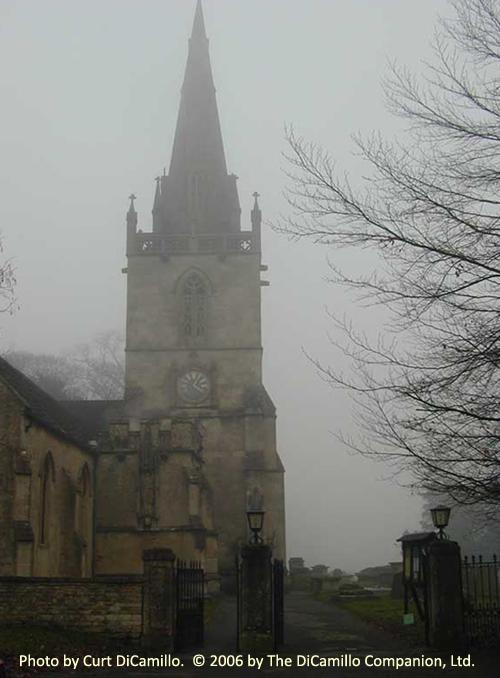
The church tower in the mist
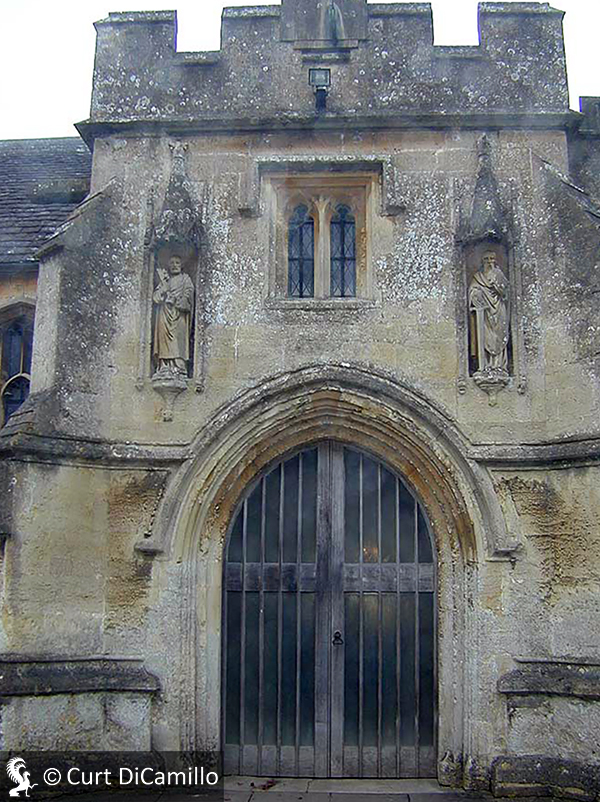
Corsham Church entrance
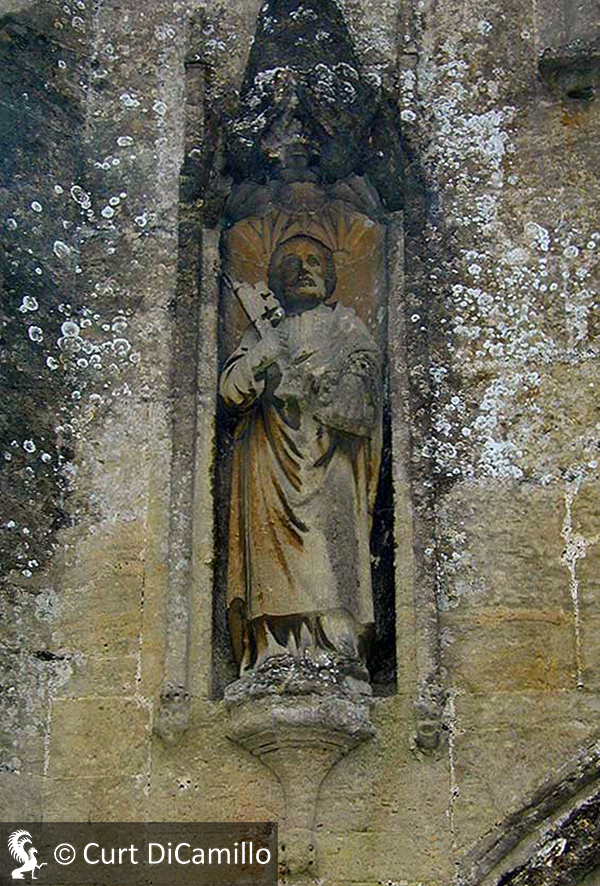
Sculpture to left of Corsham Church entrance
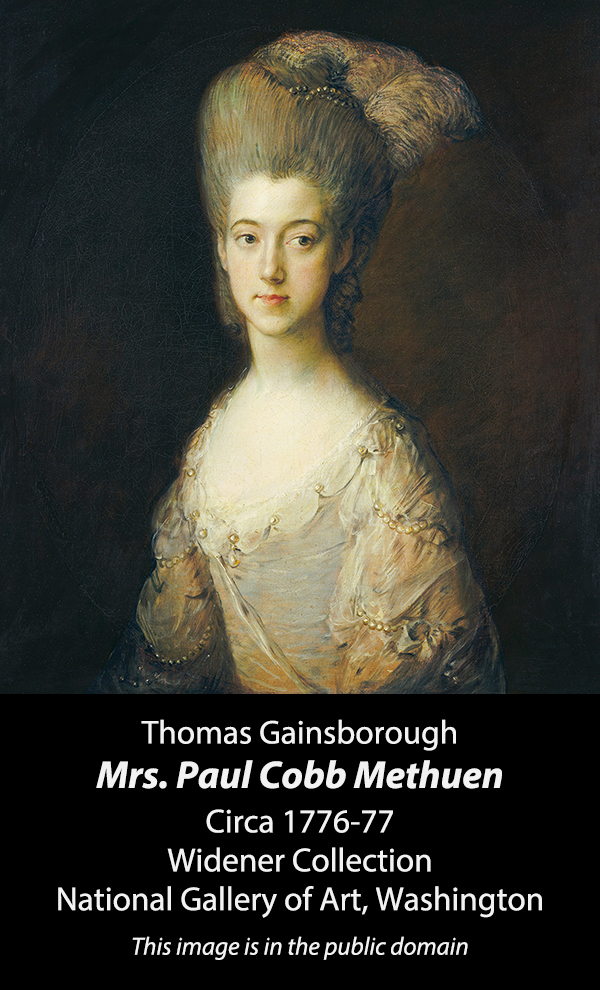
Built / Designed For: Thomas Smythe
House & Family History: "Visiting Corsham is like visiting an elderly great-aunt, albeit a magnificent one." Simon Jenkins's affectionate comment about Corsham perfectly describes this magnificent house. Corsham has not been subjected to substantial change in the last 150 years, and thus remains an outstanding example of a house and estate that has remained in the same family since the 18th century, with its great collections substantially intact. The Manor of Corsham was a royal possession from before the Norman Conquest, first recorded as such in 1016 by William of Malmesbury. In 1572 Elizabeth I leased the house to Sir Christopher Hatton, but the central part of the current house was built in 1582 for Thomas Smythe, a native of Corsham who made a fortune as collector of customs for the Port of London. The estate passed through the hands of various owners until 1745, when it was acquired for the young Paul Methuen, who took possession of the estate in 1747. The Methuen family originated in Scotland, but in the 17th century a member had settled in Bradford-on-Avon, near Corsham, and made a fortune from the woolen cloth industry there (he was described by John Aubrey as the greatest clothier of his time). His son, John Methuen (1650-1706), added to the family's distinction by serving as lord chancellor of Ireland for William III and as ambassador extraordinary to Portugal from 1703 until 1706, when he cemented vital trading links with Portugal in the famous Methuen Treaty of 1703 (the treaty allowed the export of British woolens to Portugal with a preferential 33 1/3 % tax discount on Portuguese wines in return, which caused a significant metamorphosis in British drinking customs). John Methuen's eldest son, Sir Paul Methuen (1672-1757), continued his father's public service in both diplomatic and national appointments and became treasurer of the king's household to George I. Beginning in 1715, Sir Paul collected works of art, acquiring Old Masters on the continent, but increasingly from auctions in London, including van Dyck's "Betrayal of Christ," Rubens's "Wolf and Fox Hunt," and works by Strozzi, Murillo, and Reni, as well as fine English 16th and 17th century portraits, which was kept at his London home until his death in 1757. Sir Paul's collection was inherited by his nephew and namesake, who had acquired Corsham a decade earlier; upon his inheritance of the art collection he immediately began to alter his house to accommodate his uncle's magnificent collection. In 1759-60 he commissioned Capability Brown, whose work for Lord Coventry at Croome Court, Worcestershire (1751-52), may have come to the young Methuen's attention. Brown's solution at Corsham was to double the width of the Elizabethan wings to create a 72-foot-long picture gallery specifically scaled to house Methuen's paintings, with additional rooms for a state apartment in the east wing and a library in the west wing. The rooms were fitted and decorated sumptuously in a grand Rococo style with plasterwork by Thomas Stocking of Bristol, joinery by John Hobcraft of London (who also worked at Croome), chimneypieces by Scheemakers, gilt tables and frames by Thomas Johnson, cabinet work by John Cobb, and a huge suite of mahogany seat furniture covered in crimson damask supplied by Cole of Golden Square in 1769. In 1770 Robert Adam provided designs for a set of splendid mirror frames and picture frames for the gallery and cabinet rooms. Outside, Brown landscaped the park and designed a charming bath house. Between 1797 and 1802 John Nash extended the house again (to accommodate more of the Methuen collection brought from London) by creating a grand hall, music and dining rooms, and an enlarged library, all in the Gothick style, of which little except the library survives today because the house was altered again (between 1845 and 1849) for the 1st Lord Methuen by the architect Thomas Bellamy, who was forced to pull down much of Nash's poor quality work. Bellamy created a new hall and grand staircase in a neo-Jacobean style with a massive central tower that continues to dominate the garden façade of the house today. In 1855 Lord Methuen inherited, through his wife, a remarkable collection of early Florentine and other Italian Renaissance paintings, including Filippo Lippi's "Annunciation," and Italian sculpture and furniture acquired in the early 19th century by his father-in-law, The Rev. John Sanford of Nynehead in Somerset. These pictures, with their distinctive frames, are now merged with Paul Methuen's 18th century collection of Old Masters. During World War II Corsham housed girls from Westonbirt School in one part of the house and convalescent soldiers in another. Between 1946 and 1986 Corsham was the home of the Bath Academy of Art, under the encouragement of the renowned artist Paul Ayshford, 4th Lord Methuen (1886-1974), a trustee of The National Gallery, The Tate Gallery, The Imperial War Museum, and president of the Royal West of England Academy. In recent years, negotiations with HM Treasury have ensured that the most important paintings and furniture in the Methuen collection have been accepted in lieu of inheritance tax but have been allowed to remain in situ at Corsham, thus preserving the integrity of this remarkable property. The town of Corsham is also home to the UK government's previously secret 35-acre Cold War underground nuclear bunker city, code named Burlington, located across the other side of town from Corsham Court. (We are very grateful to Lisa White and the Attingham Summer School for the bulk of this history of Corsham.)
Collections: Corsham contains one of the finest collections of Old Master paintings in Britain, including Paul Methuen's collection of 16th and 17th century Italian and Flemish paintings and statues. The collection is particularly strong in Italian paintings and includes works by Guercino, Strozzi, Reni, and Salvator Rosa, and a sweet portrait by Sofonisba Anguissola that shows the artist's two sisters and a brother. Capability Brown designed the picture gallery in 1760 specifically to house the Old Masters bequeathed by Sir Paul Methuen (1672-1757) to his cousin and godson, also named Paul Methuen. The house also contains a collection purchased in the mid-19th century of Italian masters and stone-inlaid furniture. The state room collection includes works by Chippendale, van Dyck, Reni, Rosa, Rubens ("Wolf and Fox Hunt"), Lippi ("Annunciation"), Reynolds, Romney, and a pianoforte by Clementi. Van Dyck's "The Betrayal of Christ" was turned over to the government in lieu of tax in 1981; the painting was accepted by HM Government "in lieu in situ" of estate duty tax and presented to Bristol's City Museums, Art Galleries, and Archive in 1984 and loaned back to Corsham, where it remains on display today. A circa 1776-77 Gainsborough portrait of Mrs. Paul Cobb Methuen (see "Images" section) was sold circa 1893 by the 3rd Baron Methuen; that same year Peter A.B. Widener purchased the canvas and added it to his collection at Lynnewood Hall, Elkins Park, Pennsylvania. In 1943 Peter's son, Joseph Widener, bequeathed the Gainsborough to the National Gallery of Art, Washington.
Garden & Outbuildings: Capability Brown designed the grounds, together with Humphry Repton, in the 1760s. Also in the 1760s, Brown doubled the size of the gabled wings at both sides of gateway, creating the east wing as the picture galleries. Brown also designed the Gothic Bath House and the orangery. In 2009-10 Bath Spa University re-opened the barn at the rear of the house (vacant since 1986) as its new arts center; in 2011 the university opened a new recording studio in the barn. P.G. Wodehouse described skating on the pond at Corsham Court.
Chapel & Church:
Architect: Lancelot Brown
Date: 1760-66Architect: Humphry Repton
Date: 1795-1803Architect: John Nash
Date: 1795-1803John Bernard (J.B.) Burke, published under the title of A Visitation of the Seats and Arms of the Noblemen and Gentlemen of Great Britain and Ireland, among other titles: Vol. II. p. 216, 1853.
John Preston (J.P.) Neale, published under the title of Views of the Seats of Noblemen and Gentlemen in England, Wales, Scotland, and Ireland, among other titles: 2.S. Vol. II, 1825.
Country Life: LXXX, 576 [Furniture], 1936. LXXXII, 516 plan, 548, 1937.
Title: Corsham Court Guidebook
Author: Methuen-Campbell, James
Year Published: 2004
Reference: pg. 8
Publisher: UK: Jarrold Publishing
ISBN: NA
Book Type: Light Softback
Title: Magazine Antiques, The
Author: NA
Year Published: NA
Reference: Dec 1985, pg. 1181
Publisher: New York: Bryant Publications
ISBN: 01619284
Book Type: Magazine
Title: English Country Houses: Early Georgian, 1715-1760
Author: Hussey, Christopher
Year Published: 1955
Reference: pg. 228-229
Publisher: London: Country Life Limited
ISBN: NA
Book Type: Hardback
Title: Disintegration of a Heritage: Country Houses and their Collections, 1979-1992, The
Author: Sayer, Michael
Year Published: 1993
Publisher: Norfolk: Michael Russell (Publishing)
ISBN: 0859551970
Book Type: Hardback
Title: Merchant Ivory's English Landscape: Rooms, Views, and Anglo-Saxon Attitudes
Author: Pym, John
Year Published: 1995
Reference: pg. 103
Publisher: New York: Harry N. Abrams, Inc.
ISBN: 0810942755
Book Type: Hardback
House Listed: Grade I
Park Listed: Grade II*
Current Seat / Home of: James Methuen-Campbell; Methuen family here since 1745.
Past Seat / Home of: SEATED AT EARLIER HOUSE: William of Malmesbury, 11th century. Sir Christopher Hatton, 16th century (leased from Queen Elizabeth I). SEATED AT CURRENT HOUSE: Thomas Smythe, late 16th century. Paul Methuen, 18th century; Paul Ayshford Methuen, 4th Baron Methuen, 20th century.
Current Ownership Type: Individual / Family Trust
Primary Current Ownership Use: Private Home
House Open to Public: Yes
Phone: 01249-701-610
Fax: 01249-444-556
Email: [email protected]
Website: https://www.corsham-court.co.uk/
Historic Houses Member: Yes